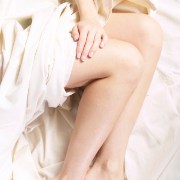Nocturnal leg cramps, when translated, simply means "cramps in the legs that occur at night." For some, the cramps only occur at night while for other they occur at night and during the day. These leg cramps can affect the feet but are largely confined to the calf muscles. In terms of an age group, nocturnal leg cramps are more likely to affect people over fifty years of age, even though there are cases of this condition affecting children. Nocturnal leg cramps are not gender specific and therefore can attack both men and women equally.
Even thought the causes of nocturnal leg cramps are unclear, the following are some possible causes that seem linked:
Sitting for long periods of time
Dehydration
Over-exertion of the muscles
Standing or working on concrete floors
Sitting improperly
More rarely, nocturnal leg cramps have been linked to certain medications, or with certain conditions. These include:
Diabetes
Peripheral vascular disease
Parkinson’s disease
Endocrine disorders
Contraceptive pills
In order to reduce the incidence of or avoid nocturnal leg cramps, staying fully hydrated is very important. Making sure you have at least 6 - 8 glasses of water each day will likely improve the condition. Stretching out periodically during the day, particularly if you are constantly sitting or constantly on your feet will also help.
Wearing comfortable, supportive and well designed shoes that really fit can help, as well as keeping your blankets loosely draped around your feet and toes so as to insure they are not cutting off your circulation at night.
Spend a few minutes riding a stationary bicycle before going to bed.
In order to relieve the cramps if they do occur, walking, jiggling the leg, stretching and heat in the form of a hot bath can help. Alternating ice and heat is always a good technique, as is massage in order to loosen the muscles.
Nocturnal leg cramps are not the same thing as restless leg syndrome. Even though both types of leg disturbances tend to happen at night, restless leg syndrome does not cause pain or cramping. Restless leg syndrome is more of a discomfort, or a crawling sensation, that results in a desire to move the legs. So long as there is movement, the restlessness is relieved, only to return when the person is still once more. This does not happen with muscle cramps in which the "knotted" muscle needs to be actively stretched out for relief.
The medications involved in the treatment of nocturnal leg cramps can bring relief. In the past, quinine was used to treat leg cramps that happened often or were severely painful. Quinine medications are currently available by prescription only due to adverse side effects. Vitamin E supplements or muscle relaxants might also be suggested. For more, see: http://my.clevelandclinic.org/disorders/nocturnal_leg_cramps/hic_nocturnal_leg_cramps.aspx or http://www.med.nyu.edu/patientcare/library/article.html?ChunkIID=100269
Aimee Boyle is a freelance writer and regular contributor to EmpowHer in sexual health and Muscles. Visit her website at http://www.straightandnarrow.yolasite.com for more information and writing samples. She lives on the shoreline of Connecticut with her beautiful family.




Add a CommentComments
There are no comments yet. Be the first one and get the conversation started!